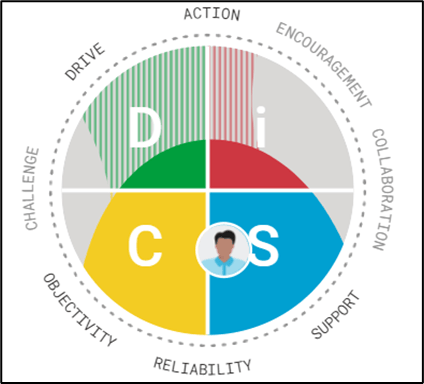People with DiSC® Behavioral Styles that show a primary High S Personality or Steadiness style are relationship-oriented and want warm and sincere relationships.
What are characteristics of a High S Personality?
 The S personality type in the DISC model, developed by Dr. William Marston, is known for being steady, stable, and predictable. Individuals with this personality are even-tempered, friendly, sympathetic, and generous with loved ones. They are understanding, listen well, and prefer close, personal relationships. However, they can also be possessive and protective of their loved ones.
The S personality type in the DISC model, developed by Dr. William Marston, is known for being steady, stable, and predictable. Individuals with this personality are even-tempered, friendly, sympathetic, and generous with loved ones. They are understanding, listen well, and prefer close, personal relationships. However, they can also be possessive and protective of their loved ones.
Tips for Remote and Video Settings
When working with High S personalities in remote, Zoom or Teams video settings, consider the following tips for effective communication and collaboration:
- Regular Check-Ins: Schedule consistent video calls to maintain personal connections and provide support.
- Comfortable Environment: Encourage sharing of feelings and concerns in a warm and welcoming atmosphere.
- Clear Communication: Use empathetic and clear communication to ensure they feel understood and valued.
- Visual Aids: Utilize screen sharing and visual guides to help them follow along comfortably.
- Patience and Reassurance: Allow time for adjustment to remote settings and offer reassurance to ease any anxiety.
High S Personality Contributions to a Team
- Reliability and Dependability: They are patient, good listeners who strive for harmonious teamwork.
- Conflict Resolution: They work hard to reconcile conflicts and seek consensus.
- Loyalty: Typically are loyal team players and compliant towards authority.
- Multi-tasking: They handle multiple tasks well and see them through to completion.
Possible Weaknesses of the High S Personality
- Resistance to Change: They prefer routines and may resist change, needing time to adapt and understand the reasons behind it.
- Avoidance of Conflict: They may hold grudges and avoid confronting issues directly, striving for positive environments and relationships.
- Sensitivity to Criticism: They are sensitive to criticism and aim to please others, which can make it difficult for them to say “No” or set priorities.
Greatest Fear of the High S Personality
The biggest fear for an S personality is the loss of security through change. They thrive on stability and peace.
To help a High S personality feel secure amidst change, employers, managers, and coworkers should focus on creating a stable and supportive environment. Communicate changes well in advance and provide clear explanations about why they are necessary. Encourage open dialogue, allowing them to express their concerns and ask questions. Offer consistent reassurance and highlight the positive aspects of the changes. Implement changes gradually when possible, giving them time to adapt. Provide a clear plan and step-by-step instructions to help them navigate through transitions smoothly. Regular check-ins and showing appreciation for their efforts will also reinforce their sense of security and stability.
Motivations for the High S Personality
- Safety and Security: They are motivated by environments that are conflict-free and harmonious.
- Recognition: They appreciate acknowledgment for their loyalty and dependability.
Ideal Environment for the High S Personality
- Team Environment: They flourish when working with others in a trusted and comfortable group.
- Stable and Predictable Settings: They prefer environments with little change or surprise and minimal conflict.
- Clear Tasks: They enjoy tasks that can be completed in one go or seen through from start to finish, along with practical procedures and systems.
Working with High S Personality Types
- Build Rapport: Be personable and build a connection. Genuine interest helps them open up.
- Support and Guidance: They may need help getting started with new projects. Allow time for processing and questions.
- Appreciation: They desire sincere appreciation for their acts of kindness.
- Specific Instructions: Provide clear, specific instructions and explanations for tasks.
- Private Feedback: Offer feedback privately, with empathy and understanding.
- Patience with Change: Be patient with changes, explain reasons, and give them time to adjust.
What to Avoid
- Avoid Confrontation: Don’t force quick decisions or use aggressive tactics. Be kind and patient.
- Firm Tone or Body Language: Avoid being confrontational or demanding as they may recoil from such approaches.
Positive Characteristics in Teams
- Relational Nature: They create a supportive and positive team environment. Utilizing team development assessments can save time and structure progress of your organization.
- Grounded Approach: They offer practical solutions and have a grounded view of achieving goals.
- Multi-tasking: They handle multiple tasks steadily until completion.
- Peacemakers: They nurture positive relationships and approach others with patience and loyalty.
Personal Growth Areas
- Openness to Change: They need to work on adapting to change and being flexible.
- Direct Communication: They should focus on being more direct in expressing their needs and opinions.
- Pacing: They may need to increase their pace to meet deadlines and accomplish goals on time.
Understanding and supporting individuals with a High S Type Personality involves patience, empathy, and a focus on building trust. By following these tips, you can create a supportive environment that allows them to thrive both personally and professionally, even in remote worker and video settings.
__________________________________________________________________
Learn about: Which DiSC® Profile to use or How DiSC® Works
Here is the full line of DiSC® Profiles :
The Everything DiSC® Workplace profile (Workplace Catalyst™ online)
The Everything DiSC® Sales profile (online)
The Everything DiSC® Management profile (online)
DiSC® Classic 2.0 Profile (online)
DiSC® Classic Profile (the original paper version)
Get information about: DiSC® Training and Certification



